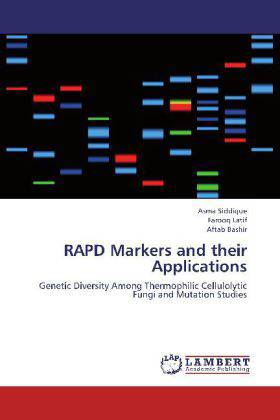
- Afhalen na 1 uur in een winkel met voorraad
- Gratis thuislevering in België vanaf € 30
- Ruim aanbod met 7 miljoen producten
- Afhalen na 1 uur in een winkel met voorraad
- Gratis thuislevering in België vanaf € 30
- Ruim aanbod met 7 miljoen producten
Zoeken
RAPD Markers and their Applications
Genetic Diversity Among Thermophilic Cellulolytic Fungi and Mutation Studies
Asma Siddique, Farooq Latif, Aftab Bashir
Paperback | Engels
€ 63,45
+ 126 punten
Omschrijving
The fungi constitute a most fascinating group of organisms exhibiting great diversity in form, structure, habit, life history and mode of nutrition. Thermophilic fungi are the only representatives of eukaryotic organisms that can grow at temperatures above 45°C and have maximum temperature of growth extending up to 60 to 62°C. Due to this reason thermophilic fungi are considered a source of a variety of thermostable proteins/enzymes. Thermostable cellulase and Xylanases are well acknowledged due to their applications in different industries and also in popularly emerging "Biofuel Industry". Similar colonial morphologies of many fungal isolates can cause problems. Random amplified polymorphic DNA (RAPD) fingerprinting is a promising method to study dissimilarities of fungal isolates on genetic level. RAPD is the simplest and less time consuming marker system to study Genetic Diversity or correlation among different fungal strains. Moreover, RAPD is also very useful tool in mutation studies. We used this technique to study relationship among different thermophilic cellulolytic fungi and for detection and confirmation of mutations in the mutants of a cellulolytic fungi
Specificaties
Betrokkenen
- Auteur(s):
- Uitgeverij:
Inhoud
- Aantal bladzijden:
- 60
- Taal:
- Engels
Eigenschappen
- Productcode (EAN):
- 9783659271564
- Verschijningsdatum:
- 18/10/2012
- Uitvoering:
- Paperback
- Afmetingen:
- 150 mm x 220 mm
- Gewicht:
- 100 g

Alleen bij Standaard Boekhandel
+ 126 punten op je klantenkaart van Standaard Boekhandel
Beoordelingen
We publiceren alleen reviews die voldoen aan de voorwaarden voor reviews. Bekijk onze voorwaarden voor reviews.








